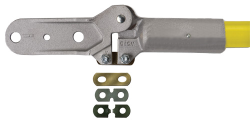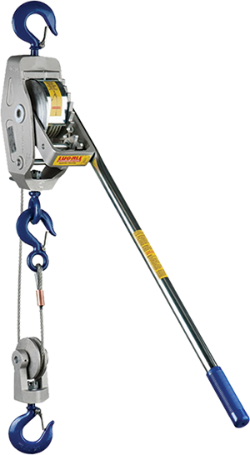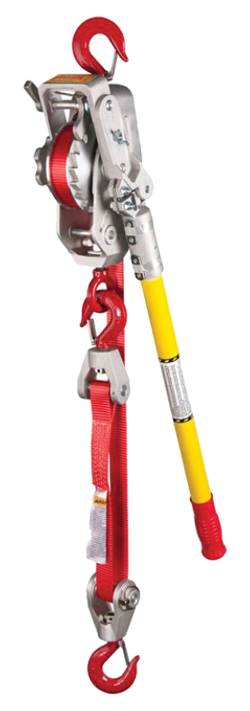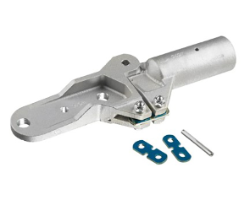- International Women's Day
27 Mar, 2025 - Compression Fitting Failures
14 Mar, 2025 - Understanding How Conduit Sealants Perform in the Presence of Fire
6 Feb, 2025 - Employee of the Year 2024
15 Jan, 2025 - National Work Safety Month 2024
9 Dec, 2024 - Wildlife Mitigation Products
21 Oct, 2024 - Lou's 25th Anniversary
14 Oct, 2024 - TEN HQ is moving
2 Sep, 2024 - Highlights from TENNET 2024
1 Jul, 2024 - The Zero Splice Rule
28 Jun, 2024 - ALE - ClampStar Conductor Repair
31 May, 2024 - System Resilience - Polywater
2 May, 2024
Hoist Overload Protection9 Jan, 2024 Hoist “Overload Protection” is designed to protect you and your hoist when it is loaded over its maximum capacity What protection is in place for you or your hoist if overload occurs, particularly if you are not using a tensioning device, such as a Dynamometer. Equipment can be accidentally “OVERLOADED” When using a hand winch hoist, one of the most important things to consider is safe use at maximum capacity. It is never advisable to use any winch or hoist above the maximum capacity, but it is not uncommon for equipment to be accidentally overloaded. e.g. Inadvertent loading during the tensioning of conductors or load shifting when lifting When an overload condition exists, it is important to know that your hoist has the necessary safety features to protect you and your equipment if the load becomes too heavy for the hoist to handle safely. These safety features are known as the overload protection. Types of “Overload Protection” Many winches or hoists on the market offer various kinds of overload protection. One common form of overload protection is the use of bendable handles or bendable handle necks, in the case of fibreglass handles. Bendable handles are designed to alert users that a hoist is overloaded by failing before the hoist itself fails. These handles or handle necks start to bend when the load applied to a winch hoist is greater than its maximum capacity, protecting the operator from injury and the hoist from severe overload damage. The amount of overload required to bend these handles may vary between manufacturers and hoist models, so it is important to know your hoist’s specific limitations. With some hoists, it is almost impossible to manoeuvre the handle to a point over the hoists capacity. Lug-All handles are designed to bend at 125-150% of the rated capacity. Breakable stress links and shear pins offer another form of overload protection in many products. This type of protection alerts you to overload conditions by snapping suddenly and audibly when overloaded. It also allows the hoist to remain functional enough to be unloaded safely and easily and removed from operation. Like bendable handles, stress links and shear pins will fail before the hoist becomes critically overloaded, preventing personal injury and damage to your hoist and other equipment. Lug-All Web Strap Hoists are equipped with a stress link system that will break at 125% capacity before the fiberglass handle or the load-bearing parts of the hoist become overloaded. Stress link and bendable handles are only affective during lifting, tensioning and releasing, when the handles are in operation. And many think this is where hoist load protection ends. Industry standards require Hoists have a safety factor built-in by design, to hold loads safely above their rated capacity. This safety factor varies depending on the hoist manufacturer and whether it’s a lifting or pulling operation. Overload protection guards your hoist against catastrophic damage when the load exceeds your hoist’s maximum capacity. Many products on the market also employ a double locking pawl system that prevents them from slipping when operating under load. This system is one of the most important features on a winch hoist because it keeps the hoist functional if it becomes overloaded. When the other protective mechanisms break to alert the user that the hoist is over its maximum capacity, the double pawl mechanism locks the load in place, preventing the hoist from suddenly releasing and allowing the user to reduce the load safely. After the load is reduced, the broken handle, stress link, or shear pin is usually easy and inexpensive to replace, saving you the cost of purchasing an entirely new hoist. Stress links and bendable handles are “ONLY” effective during operation. Without overload protection, overloading can cause your winch hoist to fail, damaging your hoist and equipment and possibly injuring you and anyone nearby, especially if a load is raised when it fails. Not all products offer comprehensive overload protection, so it is important to know what protective features your hoist offers before using it. Even before purchasing it! All Lug-All Come Along Ratchet Winch Hoists are equipped with a stress link system, shear pin, or bendable handle to protect you from possible overload damage and injury. For safe use, always be sure to replace the broken stress link, shear pin, or handle before using your hoist again. Never replace the handle with any other handle or makeshift handle, as this can lead to unsafe loading. If you consistently have the handle on your Lug-All ratchet winch hoist break or bend, you are most likely using a hoist with insufficient capacity for the application, and you should consider replacing it with a higher-capacity model. Hoist Inspection Checklist PDF The information in this guide is based mainly on several articles from Lug-All. For more information on this, please visit the Lug-All website: www.lug-all.com |





|



